This article needs additional citations for verification .(June 2019) |
| British Wildlife Centre | |
|---|---|
 | |
 Interactive map of British Wildlife Centre | |
| 51°10′24″N0°02′56″W / 51.17342°N 0.04902°W | |
| Date opened | 1997 |
| Location | Newchapel, Lingfield, Surrey, England |
| Land area | approx. 8 ha (20 acres) |
| No. of species | about 40 |
| Memberships | Visit England Quality Assured Visitor Attraction |
| Major exhibits | Deer; Foxes; Red Squirrels; Wildcats; Otters; Badgers; Pine martens; Polecats; Voles; Owls |
| Owner | David Mills |
| Public transit access | None |
| Website | britishwildlifecentre |

The British Wildlife Centre is a zoo in the hamlet of Newchapel near Lingfield village in the county of Surrey, South East England.
Contents
The zoo was founded in 1997 by David Mills, who converted his dairy farm into a centre to celebrate British wildlife. Initially, the centre was only open to pre-booked groups but in 2000 it opened fully to the general public. [1]